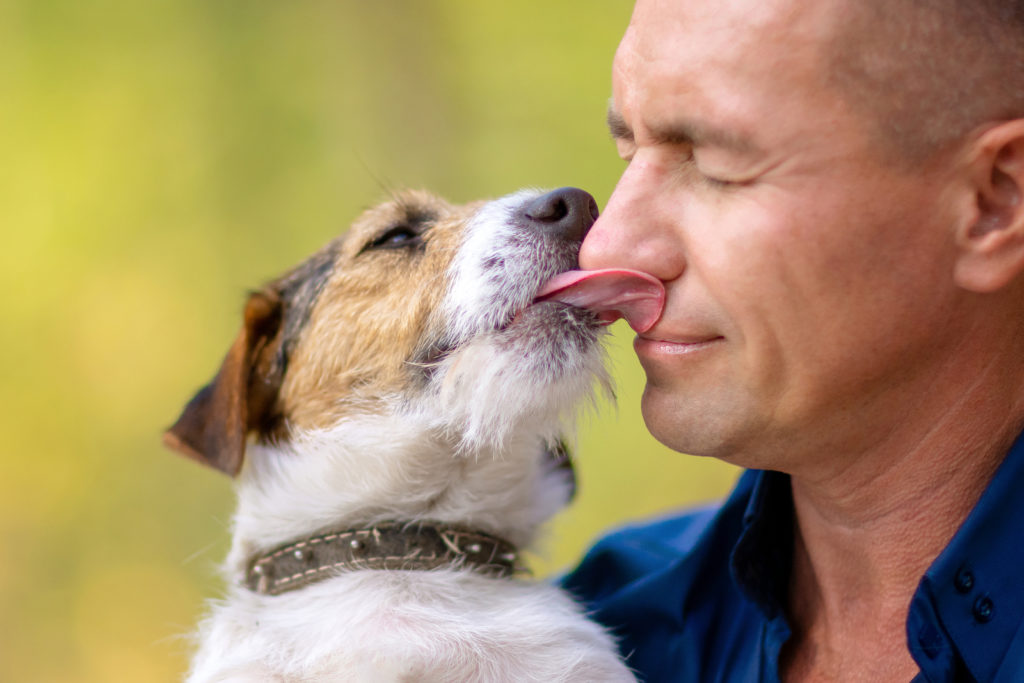There is no greater feeling when you get home to get an affectionate, although slobbery, greeting from the four-legged members of your family! Sometimes that greeting includes an ear scratch, leg bump, or a big old dog kiss sweeping across your face! Endearing? Yes. Cute? Yes. Unsanitary? Definitely.
Animal experts are in agreement on one scientifically proven fact: It is highly unsanitary for your dog to lick around your face, eyes, and nose! Dogs have been proven to carry various bacteria in their mouths that can be beneficial or non-effective to their overall health. Most of these bacteria however, are not meant to be absorbed by the human body through thin membranes such as our eyes, nose and mouth. Throughout this article, we will explore and outline the reasons why you should not let your dog kiss your face or other exposed areas such as wounds along with the potential consequences of having frequent licks from your furry companion.
Why Do Dogs Kiss to Show Affection?
According to Cesar Millan, licking behaviors stem from ingrained personality traits bred through canines as a means of communication, bonding, grooming, or even psychological problems. Mother dogs show affection to their puppies in a variety of ways to create biological bonds and they use licking as one tool from the moment of birth. The mother dog will “wake” their puppies from their post-partum state through licks, use this method to groom puppies and even teach bathroom functions. They will also feed puppies’ solid food through regurgitation licked by the young until they can digest it on their own.
Another way kisses or licks is used as a bonding tool is when two dogs meet each other, either for the first or 1000th time. Dogs will initiate a “feeling out” period and then respond with a tense posture (when they are mistrusting or wary of each other) or an enthusiastic bark combined with a lick on either the face or other area of the opposing animal. Dogs also use these displays of affection to show submission to their pack master or to let them know they are hungry, thirsty, etc. Domestic house dogs view their owner as their pack master so the ingrained behaviors are communicated in the same ways.
Dogs who show signs of excessive licking towards humans or objects can also be disguising deeper mental problems. Such issues could be separation anxiety (the fear of being alone) or being nervous in their surroundings due to noise, crowds, smells etc.
Why Not to Kiss?
Dr. Neilanjan Nandi, has stated that a dog’s mouth is host to “an enormous oral microbiome of bacteria, viruses and yeast.” The term “zoonotic” is frequently used to describe the bacteria that reside in your dog’s mouth that is able to be passed on to humans and cause disease.
A dog spends the majority of their time nosing around in areas where they shouldn’t or we wouldn’t even think to take a healthy sniff! The majority of humans would not nose around another person’s rear end (feces) or take a whiff/taste of some random garbage left on a sidewalk, or take a refreshing drink from the toilet bowl (one can assume) but your dog? They definitely would exhibit one if not all these behaviors. This means that not only is your dog’s mouth a host to these bacteria but their muzzles can be as well. Additional bacteria are also transferred when your dog takes a moment to wrap their tongues around their muzzle for a quick cleanup!
The Dangers of Dog Kisses
The top five bacteria that could be transferred through the face and/or mouth are outlined in a short summary below:
1. Capnocytophaga Canimorsus: An organism carried in the mouths of dogs, and it causes a very bad sepsis infection.
2. Staphylococcus Aureu (Staph Infection): The majority of time your dog can safely carry this virus strain without it affecting their overall health, but when transferred to a human it can have life-threatening consequences.
3. Ringworm or Hookworm: Can cause either painful itchy infections or inflammation, or even intestinal bleeding depending on the point of entry.
4. E.Coli: A potentially fatal bacterial disease with symptoms ranging from diarrhea to nausea to intestinal bleeding.
5. Salmonella: A painful bacterial disease that can cause diarrhea, intestinal cramping, nausea and vomiting.
Conclusion
Dog’s are generally affectionate lovable creatures and we would never want to discourage or diminish that side of their personalities because the feeling of walking in the door and getting a hero’s greeting is a confidence booster one thoroughly enjoys. Setting boundaries, however, in how our dogs display that affection can be beneficial for everyone!

